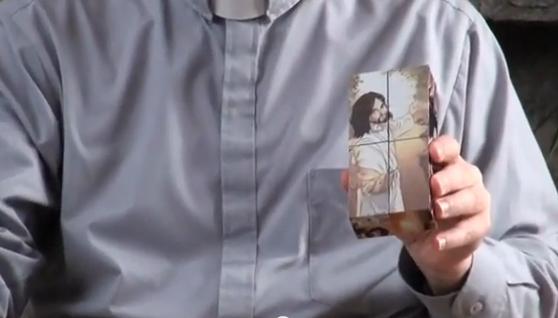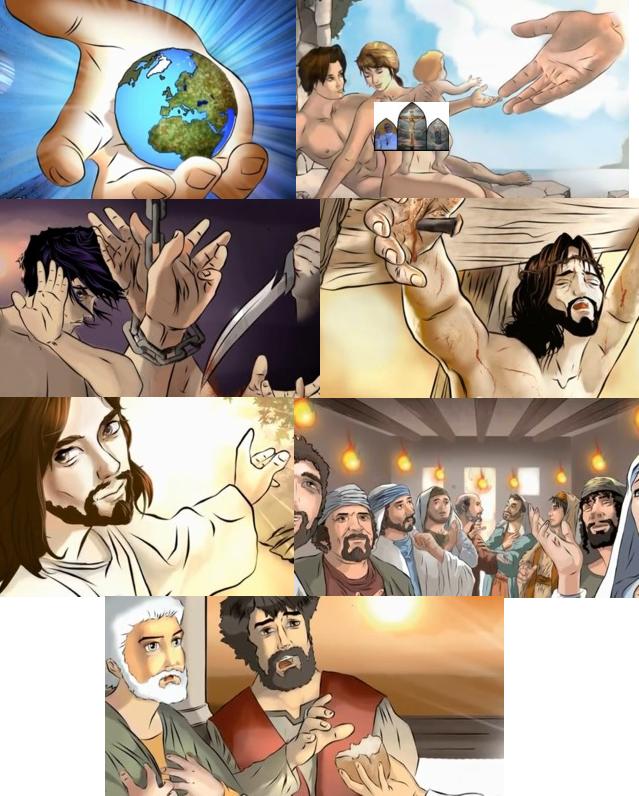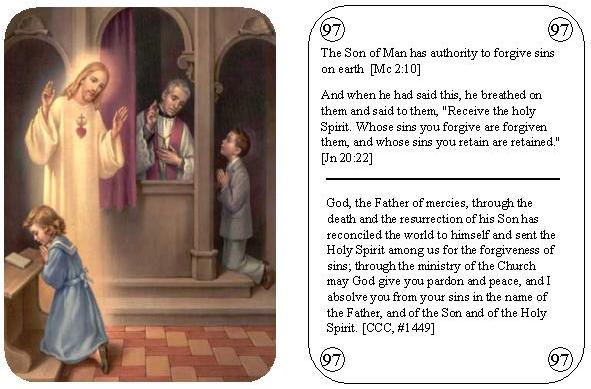
Father Mario St-Pierre holding a Kerycube.
[Source]
Let's Adore Jesus-Eucharist! | Home >> Lost Sermons

Father Mario St-Pierre holding a Kerycube.
[Source]
A buddy recently asked me to review the "KeryCube, a game to spread the Gospel".
Disclaimers: (i) this is just a quick review, based on a few hours of reading the "Participant's Manual" and sifting through a few YouTube videos on their web site [Source]; (ii) according to my informants, Father Mario St-Pierre was shown the door out of the diocese of Quebec because he's is one of the rare priests to have had the courage of speaking out against Monsignor Lacroix's Demolition Derby; (iii) this whole "Kerycube" thing is designed to convert people to Catholicism, but that is exactly my weakness (i.e. sadly I don't think I've ever converted anybody), so I'm like a carpenter who has never succeeded in cutting a piece of wood, and who decides to review a saw!
I think the KeryCube is basically two things: a simple physical object, and a complicated theory behind it. The simple object is just one big cube made up of eight little cubes. Since the eight little cubes are partially connected (imagine taping some of them together with duck tape), you can unfold and re-fold the big cube in a few ways. Since seven images are pasted to those configurations, you can change the configuration and view the images.
The complicated theory would probably require me to read all the books available on the topic, as well as research the origins of this idea. Roughly, the KeryCube seems to be an incomplete Catholic adaptation of the protestant "EvangeCube", to which has been added a bit of biblical Greek jargon (like the word "kerygma" which just means "preaching", hence the "PreachingCube" or "KeryCube"), and a lot of "let's form small groups and share our feelings".

Seven images of the KeryCube.
[Source]
The method to use the KeryCube seems to be: (i) pick a target-person during one of your prayer sessions; (ii) ask the Holy Spirit to convert that person; (iii) draw the attention of that person using the KeryCube "game"; (iv) walk that person through the seven images (Creation, Original Sin, Crucifixion, Resurrection, Pentecost, Eucharist) and appropriate Gospel quotes, in order to try to elicit an act of Faith in Jesus Christ as their personal saviour.
Here are some advantages of the KeryCube:
3.1) It's better than nothing. At least Christians are trying to convert Pagans! That seems obvious and a bit silly, but in the Province of Quebec, the apostasy has penetrated so deeply that the very idea of Priests and simple faithful actually doing something to spread the Gospel is somewhat of a shocking novelty!
3.2) Bible-centered. Here again, Christians are encouraged to quote important passages of the Gospels to non-Christians, as well as become themselves better acquainted with the Bible. And here again, obvious, but somewhat of a shocking novelty!
3.3) A rudimentary path is suggested. The fundamental problem in getting somebody to do something practical is: "OK, where do I start? What do I do?" The KeryCube material does provide practical advice on how to approach people, what to tell them, and in what order to tell them. The Catholic religion is a big, complicated thing. Convincing somebody that it's true is not easy, so some kind of "sales pitch" script could be useful.
3.4) Protestants would never go near it. No Protestant would dare touch this material (this is a very good sign!), there are too many quotes from Papal documents and the Catechism of the Catholic Church (CCC). The textbooks also have an "Imprimatur" from Monsignor Gérald-Cyprien Lacroix.
Etc., etc...
Here are some disadvantages of the KeryCube, in roughly decreasing order of importance:
4.1) Serious misunderstanding of the act of Faith. The act of Faith is presented as being somewhat irrational. For example: "[...] the main caracteristic of the kerygma is to present an event which calls for no explanation nor justification. The art of the preacher or the gospel-spreader is to provoke, in a great climate of freedom, the evangelized person to take a decision in faith. [...] Since Jesus has saved you by his death and resurrection, believe and you shall be saved!", [p. 60, "Le Kérycube; manuel du participant", Éditions Néhémie, 2011].
Nowhere do they mention the "reasons to believe", the "motives of credibility", which any good Catholic preacher knows about. The Church clearly teaches that:
Nevertheless, in order
that the obedience of our faith might be in harmony with reason, God willed
that to the interior help of the Holy Spirit there should be joined exterior
proofs of His Revelation
[Denzinger, #3009]
For to the Catholic Church alone
belong all those many and admirable tokens which have been divinely established
for the evident credibility of the Christian faith. Nay, more, the Church by
itself, with its marvelous extension, its eminent holiness, and its
inexhaustible fruitfulness in every good thing, with its Catholic unity and its
invincible stability, is a great and perpetual motive of credibility, and an
irrefutable witness of its own divine mission.
[Denzinger, #3013]
No wonder they can't figure out what justification this act of Faith could have; they've removed the Catholic Church, so all motives of credibility are gone! Notice also how the Act of Faith of the "Little Catechism" easily solves all these problems:
My God, I believe everything the Holy Catholic Church teaches and believes, because You said it, and You are truth itself.
Notice also that once you've made a strong connection between Faith and the Church, it becomes clear why we talk about the CCC, and not just the Bible. Notice also that historically, the first Christians didn't believe in the Gospel transmitted by the Bible (the Bible we have today didn't exist as such in the beginnings of Christianity), they believed in the Gospel transmitted by the Church.
4.2) Intellectual and spiritual poverty. The poverty of the KeryCube is strikingly opposite of the incredible intellectual and spiritual wealth of the Catechism of the Catholic Church. The CCC is the second most essential tool for spreading the Gospel, after the Bible. Of course, nothing prevents you from having your CCC with you, but nothing in the KeryCube pedagogical material encourages this. This is another consequence of the protestantization of the act of Faith. The only true Church of Christ and all her millenia of thought and art and music and apologetics and so on and so forth, are just ignored.
There are quotes from Popes and the CCC, but nothing in the KeryCube material explains the connection between those quotes and Jesus. Those quotes could be removed and nothing would be missing from the KeryCube approach, because it's a fundamentally Protestant approach.
4.3) Inexistant target audience of "good savages". If a missionary landed on a island filled with savages who had never heard of the Gospel, and who were still in the Stone Age, a KeryCube might interest them. But in the Province of Quebec, a vigorous propaganda effort by Satan has infected most French-Canadians with anti-Catholicism (and smartphones have made all inanimate objects very boring). You don't believe me? Grab a KeryCube and let's go talk to normal people. As soon as they detect the slightest whiff of religion, they will immediately ask which church you are part of. Upon hearing your are Catholic, they will bombard you with the usual lies and run for it. There is a reason why Fr. Mario St-Pierre, when he is videotaped explaining the KeryCube, does it in front of a small group of little old ladies, who are most certainly already Catholics. He couldn't have gone outside and given it a try in front of average French-Canadians.
4.4) No bibliography. The "Participant's Textbook" doesn't include a list of related books on Catechesis, Apologetics and Polemics. This robs the reader of all the accumulated wisdom of the Church, but also gives the impression that the KeryCube is a new novelty.
4.5) Physically bulky and fussy and fragile. The physical KeryCube is basically seven images. But it's hard to see those seven images (you need some fine motor skills to configure the cube correctly, and then you must not move while you're trying to show an image). Also, you can't put a KeryCube in your pocket. And unless they are made of solid plastic, I assume if you sit on your KeryCube your "faith" will be squashed!
4.6) Ugly and incorrect images. "De gustibus non est disputandum", but I find the images ugly. There is so much beautiful religious art out there, why chose seven ugly images? Also, you could argue many are incorrect. For example, Adam and Eve had their first child after Original Sin (and therefore after they made cloths for themselves because they were ashamed of their nakedness). Also, there were not only nine Apostles when the Holy Spirit came down during Pentecost. Finally, you can call me a puritain but I don't walk around with pictures of naken women, so I wouldn't even want to own a KeryCube the way it's currently made (see censored image of Eve above).
4.7) It's a "game" that can't be played. The publicity often refers to the "game" of KeryCube. Except that it's not a game. A game is like monopoly, or chess, or hockey: there is a goal, and there are means to reaching that goal, and either you make the right moves and win, or you make bad moves and you lose. The KeryCube is just seven images. They should correct their marketing material, to avoid false hopes.
4.8) Commercial, copyrighted material. There is a whole slew of stuff to buy if you want to use the KeryCube. A textbook for the teacher, a workbook for each student, and of course the cubes themselves. Strange. When I try to spread the Gospel, I do it for free.
It's easy to criticize, but how could we do better? I'd start by dropping the cube: it's just needlessly complicated and fragile, while offering too few images, and no words (and remember, "Faith comes through hearing", i.e. hearing words! Rm 10:17). Then, I'd steer toward a solution with the following characteristics:
5.1) The physical object: a pack of cards. I claim mankind, over hundreds of centuries, has developped a physical object which cannot really be improved upon anymore: the pack of cards. Think of all the advantages of an average pack of cards: (i) the pack is fairly small, easy to hold in one hand and easy to carry with you; (ii) you can sit on the pack without breaking it; (iii) each card has rounded corners which don't wear out as quickly as pointed corners; (iv) each card is laminated so they don't get dirty easily and don't get damaged by a bit of liquid; (v) each card can hold two sides of information; (vi) being made of simple materials, these cards are not expensive; etc.

The two sides of a possible card in the KeryPaq.
5.2) The format of the content of a card. On each card, one side would have a beautiful religious image. The other side would have in the four corners the number of that card to identify it, but also on top some essential Biblical quotes, and on the bottom quotes from the Catechism of the Catholic Church.
5.3) Flexibility of pathways compared to a book. Lets compare a book and a pack of cards. A book has its advantages, and the pack of cards other advantages. A book can be thought of as a kind of pack of cards where we're limited to one single configuration: you start by looking at the first "card", then the second "card", then the third, etc. A pack of cards can itself be thought of as a kind of book, but where we can re-arrange the "pages" with great flexibility. With a pack of cards, we can therefore compose very quickly a "book" perfectly adapted to the flesh-and-blood reader we have before us. Does this reader only need a few pages? Bam, we lay out a few cards on the table and here is a "book" with just the right subset of "pages". Does this reader have specific shortcomings in his training? Bam, we can change the order of the "pages" to start where he will be able to understand. Is this reader predisposed to reject some steps in our argumentation? Bam, we can place around the problematic "pages" some other "pages" which will answer his objections, and so on.
5.4) The kerygmatic pathways (preaching series). Ideally there would be, free on the Internet, some series of card numbers. These series of numbers would be like "little books", "suggested pathways", "scripts to know how to approach such a listener", etc. For example:
The Life of Jesus (Annunciation, Visitation, Birth, Passion, etc.);
The Seven Sacraments;
The Gospel of Life (why the Church is against abortion, divorce, contraception,
etc.);
Old Testament History
(Creation, the Fall, Moses and the burning bush, the exile in Babylon, etc.);
The existence of God, Supreme Being;
The Ten Commandments;
Etc, etc.
5.5) A second more "polemical" pack. The original KeryPaq would be oriented more toward Apologetics and Catechesis. But we'd also need an "Attack-KeryPaq", a second pack of cards which would be more like ammunition to shoot down objections from anti-Catholics (i.e. what is traditionally known as "Polemics"). They would be smaller, so it would be easy to separate them from the big ones if they got mixed up (but also to visually show that positive teachings of the Faith are more important than answers to objections). These small cards would contain on one side brief replies to objections, and on the other references to more information in sources like the Summa Theologica by Saint Thomas Aquinas, or the Denzinger, or "Fundamentals of Catholic Dogma" by Ludwig Ott, etc. They would not have any images. Of course, these cards would also be numbered, and could therefore be used in the "kerygmatic pathways". In other words, while you would be explaining a big card (Catechesis and Apologetics), you could know which objections against this truth of Faith or Morals are most frequent, and how to answer them (Polemics).
5.6) Complementarity of the KeryPaq with the CCC and the CCCC. Another way to see the KeryPaq is to look at the Compendium of the CCC. Everybody can see that the CCC as such (not the Compendium) is big, hard to understand, hard to memorize and contains less images than the KeryCube. The Compendium of the CCC tried to reduce the amount of words and increase the amount of images. The KeryPaq would contain even less words and even more images than the Compendium.
5.7) Image selection. Ideally these images, on top of being beautiful to look at, would also be pedagogical. Unfortunately, the example I had in mind is somewhere on Father Z's site, and I don't remember where. It's an image showing a confessional, with one penitent going in, and one coming out. The one going in has a demon pulling on the chain around his neck. The penitent coming out is accompanied by his guardian angel, and the chain is gone. This is a vivid illustration of one of the effects of this Sacrament. Some other nice pictures are here, here, here, here, here, here, etc.
I would not recommend the purchase of the KeryCube and associated textbooks. On the other hand, I'd love to buy a KeryPaq!
That being said, the best tool to spead the Gospel is illustrated right here at the top of this page (and no, it's not the KeryCube!). It is a Catholic Priest. Yes, lay faithful have a role to play in spreading the Gospel, but the person best equipped to do this job is the Priest. The Priest gives up the possibility of getting married and having children, so he can dedicate his entire life to spreading the Gospel. The Priest studies Philosophy and Theology for many years, so he can explain the Catholic Faith and answer a myriad of objections (a task far too complex for a physical object, whether a cube or a pack of cards). And only a Priest can forgive sins and transform a humble piece of bread into the body, blood, soul and divinity of Our Lord Jesus Christ.
I find it striking that the Bishop who was so quick to grant the "Imprimatur" to this semi-Protestant contraption is the same Bishop who has a deserted Seminary, a Seminary that has actively been chasing away good hemen for decades, and which continues to do so. As they say in French: Père manquant, Fils manqué. (Absent Father, wasted Son).
Let's Adore Jesus-Eucharist! | Home >> Lost Sermons